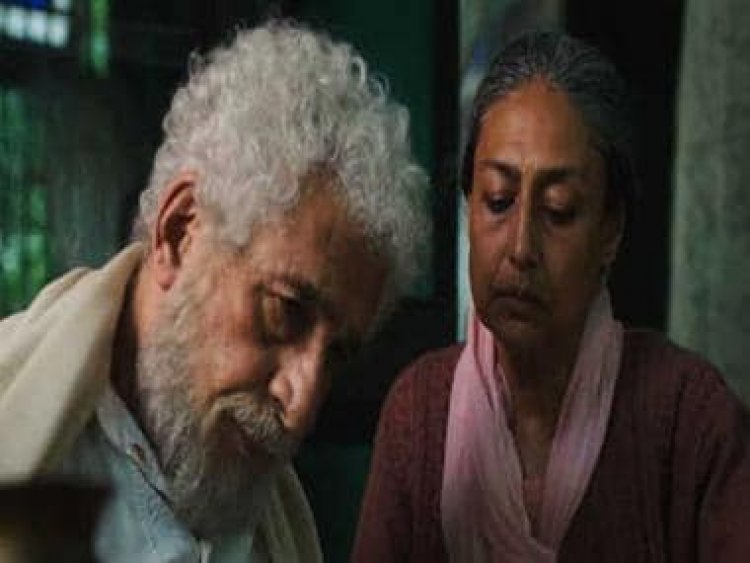Naseeruddin Shah-starrer The Miniaturist Of Junagadh manages to score in many ways in less than half an hour
Naseeruddin Shah-starrer The Miniaturist Of Junagadh manages to score in many ways in less than half an hour

Kaushal Oza’s short film manages to be many things within a runtime of less than half an hour. It defines good storytelling, and sets up drama through a complex interplay of emotions. The film is understated in its portrayal of an artist’s devotion to his art, and the power of art to transform people. It is nuanced in the way it conveys loss and longing in the time of calamity. Oza also crafts a quiet comment on divisive perceptions and intolerance, and his focus all along on drawing up a layered plot and characters for a fine cast makes the film a worthwhile watch.
The film borrows its core from Stefan Zweig’s story, Der Unsichtbare Ammlung (The Invisible Collection), and repositions the idea as an original screenplay set in the winter of 1947. At the centre of the narrative is Naseeruddin Shah as Husyn Naqqash, an aged miniaturist who was once a star in the Nawab’s court. Left sightless after pursuing his intricate art for decades, Husyn is forced to sell his ancestral home in Junagadh in the chaotic aftermath of Partition and move to Karachi with his family, comprising his wife (Padmavati Rao) and daughter (Rasika Dugal).
The man buying Husyn’s house is Kishori Lal (Raj Arjun), an opportunistic merchant who is clearly a bigot and without any concern whatsoever about Husyn and his family’s current predicament. Cunning to the core, Kishori has ensured that the sale deed gives him legal right to not just Husyn’s house, but also everything in it barring the family’s immediate personal possessions. When Kishori comes to know of Husyn’s collection of rare and priceless miniature art, he decides he must have it, too. What he is not aware of, though, is the fact there is a secret about the paintings that, as Husyn’s daughter tells him, would bar him from having them.
Director Oza, who also screenplays the film, is effective in the use of silences to set up the mood as he builds the drama entirely around four characters. Indeed, the only other character in the film is the pet cat of the household — Oza’s use of this fifth ‘protagonist’ is brilliant while underlining the film’s message of hope, humanity and the power of art in the final scene.
If the storytelling is paced in a way to let the audience connect with the protagonists’ emotional state, the film’s tech-specs add to the impact. Kumar Saurabh’s cinematography and Amit Malhotra’s editing add to the muted execution, crafting a period appeal that works in harmony with Nitin Zihani Choudhary’s production design, Sanjeev Sharma’s art direction and Nivedita Das’ costume design. The use of music (Chhavi Sodhani) is sparing — just about right to add to the mood in a narrative that is primarily out to depict the silent suffering of a family left rootless amidst the biggest political turmoil the nation has seen.
Naseeruddin Shah is an actor you look forward to, every time you see his name in the titles of a film. Here, the veteran reiterates once again he doesn’t need too many scenes to leave an impact. Shah executes Husyn Naqqash with gravitas befitting a royal artist, and yet mixes the statuesque air with the miseries of an old man left to fend against unknown perils in the winter of his life. Dugal as his daughter and Rao as his wife are effective, too, while living out characters that are a blend of agony and resilience. Raj Arjun’s Kishori Lal traverses a dramatic arc that would fall short of being credible had it been written or performed with any less conviction.
Partition tales set in western India — specifically about people who were rendered homeless in the region during the era — are uncommon, which gives Oza’s film an edge. The writer-director avoids overt focus on the socio-political realities of the nation back in 1947, except leaving a hint of the same through the resentment Raj Arjun’s character harbours towards Husyn and his family to begin with. The short film format could be a reason Oza avoided delving into such details, but the approach of underplaying the political tension outside Husyn’s household lets him score with the impact it had on people inside homes and, more pertinently, their minds. Admirably crafted and ably acted out, The Miniaturist Of Junagadh takes all of 29 minutes to reiterate what good cinema is all about.
Vinayak Chakravorty is a critic, columnist, and film journalist based in Delhi-NCR.
Read all the Latest News, Trending News, Cricket News, Bollywood News, India News and Entertainment News here. Follow us on Facebook, Twitter and Instagram.
What's Your Reaction?




























































